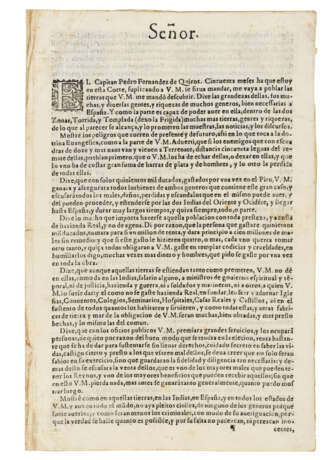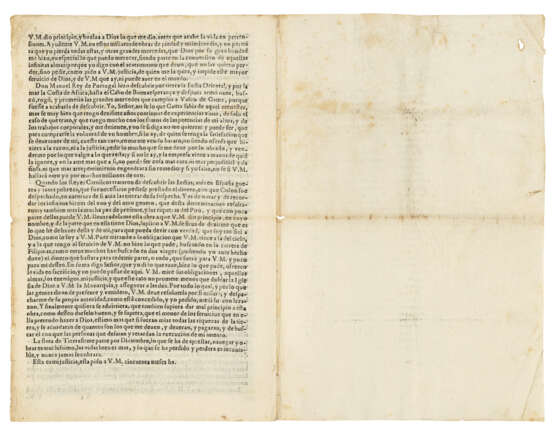ID 870892
Lot 133 | QUIROS, Pedro Fernández de (1565-1614)
Valeur estimée
£ 70 000 – 100 000
[ELEVENTH MEMORIAL:] Senor. El Capitan Pedro Fernandez de Quiros. Cincuenta meses ha que estoy en esta Corte, suplicando a V.M. se sirua mandar, me vaya a poblar las tierras que V.M. me mando descubrir... [Madrid: November-December 1611].
One of only four copies known to survive, petitioning King Philip III of Spain for authorization to populate the Southland. '[The] beginning of European material relating to Australia are the Spanish memorials, but these are so rare that it would be only academic to list them' (Davidson p.25).
Pedro Fernandes de Queiros (1563[5?]-1614), Portuguese by birth, became a Spanish subject when the two countries were temporarily united following the Portuguese succession crisis of 1580. Known generally by his Castilian name, Quiros spent several years sailing between the Philippines and Mexico, and later served as pilot on the second voyage of Alvaro de Mendaña which set out from Peru in 1595 to colonize the Solomon Islands. Despite the grueling nature of the Mendaña expedition, it inspired in Quiros a belief that he would discover the great southern continent (Terra Australis) for Spain and the Church. In 1601, upon his return to Europe, Quiros managed to get an audience with Pope Clement VIII, and having secured letters of support from both the pontiff and the Spanish ambassador to Rome, the Duke of Sesa, he returned to Spain where he found found the new Spanish king, Philip III, enthusiastic about a new Pacific expedition.
In March 1603, Quiros was finally authorized to make another voyage to convert the heathen and extend the Spanish dominions. His departure was delayed by being shipwrecked in the West Indies, but he set out from Callao in Peru with a fleet of 3 ships in December 1605 to discover the great southern continent. Reaching Vanuatu in 1606, Quiros believed he had discovered Terra Australis and, forming a portmanteau, named it La Austrialia [sic] del Espiritu Santo that also honoured the Spanish king's descent from the House of Austria. Although but a promontory on the largest island of the archipelago, Quiros optimistically claimed it for Spain along with the Pacific as far south as the South Pole, and planned to establish a colony called Nova Jerusalem. However, after less than month, these plans had to be abandoned, and after period of bad weather Quiros' ship was separated from the other two, and Quiros sailed back to Mexico. He returned to Spain in 1607, and wrote some 65 memorials of his experiences, constantly appealing to Philip III for further funding for another voyage south. The present memorial is one of these confidential documents; only 14 were printed, all for presentation. Later, some were subsequently published in several collected editions of voyages, and did much to establish Quiros' reputation as the father of exploration for the southern continent. He had, after all, sailed some 8000 miles from Peru to Vanuatu, and was only 1200 miles distant across the Coral Sea from the east coast of Australia.
In the present memorial, known as the Eleventh Memorial, presented to Philip III late in 1611, Quiros reminds the King that he has been petitioning for 50 months and that the cost of the expedition would be 500,000 ducats. He emphasizes the benefits to the Crown of the colonization and suggests a form of government run by carefully chosen civil servants which, in contrast to that of the Indies, would be cheap to administer and bring large revenues. He repeats his own qualifications to carry out the plan and reminds the King of the success of Columbus' voyage, undertaken during a time of war and poverty in Spain. We can only trace 2 copies in institutions: one in the Archivo General de Indias, Seville, the other in the Dixson Library, Sydney. Kelley 709; Palau 89603.
Small folio (280 x 183mm). 4 leaves, the final blank, disbound (faint vertical and three horizontal creasefolds, some light soiling on verso of final blank, very light creasing at extreme edges, tiny holes where stitching removed). Contained in a modern morocco box.
Special notice
No VAT on hammer price or buyer's premium.
| Lieu d'origine: | Europe, Espagne |
|---|---|
| Catégorie maison de vente aux enchères: | Livres imprimés |
| Lieu d'origine: | Europe, Espagne |
|---|---|
| Catégorie maison de vente aux enchères: | Livres imprimés |
| Adresse de l'enchère |
CHRISTIE'S 8 King Street, St. James's SW1Y 6QT London Royaume-Uni | |
|---|---|---|
| Aperçu |
| |
| Téléphone | +44 (0)20 7839 9060 | |
| Commission | see on Website | |
| Conditions d'utilisation | Conditions d'utilisation |






